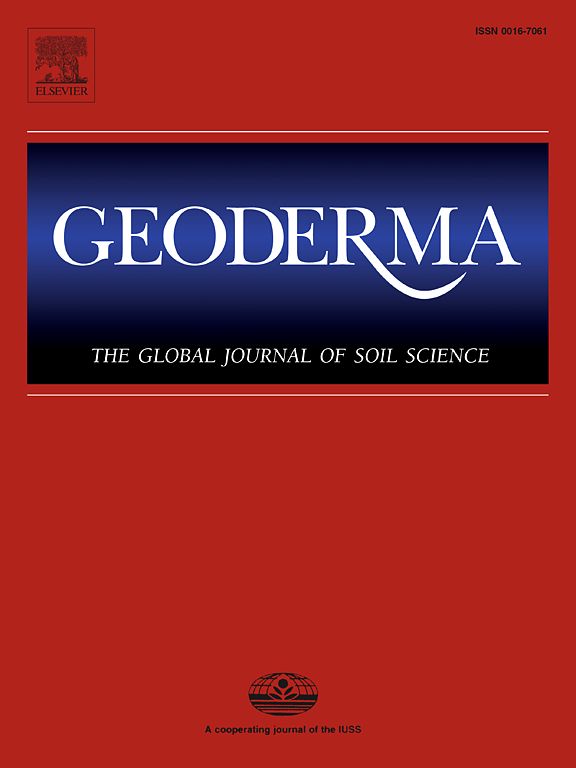Hairy vetch influence on nitrous oxide and nitrate leaching losses during corn growing seasons in reduced and no-till systems
IF 6.6
1区 农林科学
Q1 SOIL SCIENCE
引用次数: 0
Abstract
Shifting from reduced tillage (RT) to no-till (NT) often reduces phosphorus (P) runoff by minimizing soil erosion. However, it might increase nitrous oxide (N2O) emissions or nitrate-N (NO3-N) leaching. Including a legume cover crop such as hairy vetch (Vicia villosa L.) before corn (Zea mays L.) is a common practice among growers in the Midwest USA. However, the effects of hairy vetch following soybean (Glycine max L.) harvest on NO3-N leaching and N2O emissions during the following corn season in soil with clay and fragipans are less assessed. This study evaluated the influence of cover crop (hairy vetch vs. no-CC control) and tillage systems (NT vs. RT) when 179 kg ha−1 nitrogen (N) was applied at planting on (i) corn yield, N uptake, removal, and balance; (ii) N2O emissions and NO3-N leaching; (iii) yield-scaled N2O emissions and NO3-N leaching during two corn growing seasons. We also evaluated factors influencing N2O emissions and NO3-N leaching via principal component analysis. Corn grain yield was higher in RT (8.4 Mg ha−1) than NT (6.2 Mg ha−1), reflecting more available N in the soil in RT than NT, possibly due to the favorable aeration and increased soil temperature in deeper soil layers resulting from tillage. Hairy vetch increased corn grain yield and soil N. However, it led to higher losses of both N2O-N and NO3-N, indicating that increased corn grain yield, due to the hairy vetch’s N contribution, also resulted in higher N losses. Yield-scaled N2O-N emissions in NT-2019 (3696.4 g N2O-N Mg−1) were twofold higher than RT-2019 (1872.7 g N2O-N Mg−1) and almost fourfold higher than NT-2021 and RT-2021 indicating in a wet year like 2019, yield-scaled N2O-N emissions were higher in NT than RT. Principal component analysis indicated that NO3-N leaching was most correlated with soil N availability and corn grain yield (both positive correlations). In contrast, due to the continued presence of soil N, soil N2O-N fluxes were more driven by soil volumetric water content (VWC) with a positive correlation. We conclude that in soils with claypan and fragipans in humid climates, NT is not an effective strategy to decrease N2O-N fluxes. Hairy vetch benefits corn grain yield and supplements N but increases N loss through NO3-N leaching and N2O-N emissions.

毛豆对免耕和免耕玉米生长季氮氧化物和硝态氮淋失的影响
从减少耕作(RT)到免耕(NT)的转变通常通过减少土壤侵蚀来减少磷(P)径流。然而,它可能会增加一氧化二氮(N2O)的排放或硝态氮(NO3-N)的浸出。在玉米(Zea mays L.)之前包括豆类覆盖作物,如毛豌豆(Vicia villosa L.)是美国中西部种植者的普遍做法。然而,大豆收获后毛缕豌豆对玉米季含粘土和软泥土壤NO3-N淋溶和N2O排放的影响评价较少。本研究评估了179 kg hm - 1氮素(N)对玉米产量、氮素吸收、去除和平衡的影响,评估了覆盖作物(毛豆对照与无氮肥对照)和耕作制度(NT对照与RT对照);(ii) N2O排放和NO3-N浸出;(iii)两个玉米生长季节N2O排放和NO3-N淋溶的产量比例。我们还通过主成分分析评估了影响N2O排放和NO3-N浸出的因素。玉米产量在全耕条件下(8.4 Mg ha - 1)高于全耕条件下(6.2 Mg ha - 1),反映了全耕条件下土壤有效氮含量高于全耕条件,这可能是由于耕作使深层土壤通气性良好,土壤温度升高所致。毛缕豌豆增加了玉米产量和土壤氮,但导致N2O-N和NO3-N损失增加,说明由于毛缕豌豆对N的贡献,玉米产量的增加也导致了更高的N损失。NT-2019产量尺度N2O-N排放量(3696.4 g N2O-N Mg−1)是RT-2019 (1872.7 g N2O-N Mg−1)的2倍,几乎是NT-2021和RT-2021的4倍,这表明在2019年这样的湿润年份,NT产量尺度N2O-N排放量高于rt。主成分分析表明,硝态氮淋溶与土壤氮有效性和玉米产量最相关(均为正相关)。相反,由于土壤N的持续存在,土壤N2O-N通量更多地受到土壤体积含水量(VWC)的驱动,并呈正相关关系。因此,在潮湿气候条件下的粘土和泥质土中,NT并不是减少N2O-N通量的有效策略。豇豆有利于玉米籽粒产量和补充氮素,但通过NO3-N淋溶和N2O-N排放增加氮素损失。
本文章由计算机程序翻译,如有差异,请以英文原文为准。
求助全文
约1分钟内获得全文
求助全文
来源期刊

Geoderma
农林科学-土壤科学
CiteScore
11.80
自引率
6.60%
发文量
597
审稿时长
58 days
期刊介绍:
Geoderma - the global journal of soil science - welcomes authors, readers and soil research from all parts of the world, encourages worldwide soil studies, and embraces all aspects of soil science and its associated pedagogy. The journal particularly welcomes interdisciplinary work focusing on dynamic soil processes and functions across space and time.
 求助内容:
求助内容: 应助结果提醒方式:
应助结果提醒方式:


